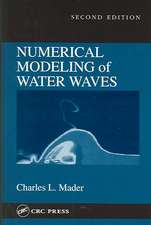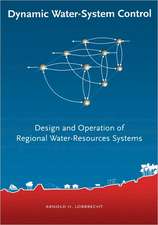Hydraulic Modelling: An Introduction: Principles, Methods and Applications
Autor Pavel Novak, Vincent Guinot, Alan Jeffrey, Dominic E. Reeveen Limba Engleză Hardback – 25 ian 2010
Considering the advantages and limitations of both physical and mathematical methods, this book will help you identify the most appropriate form of analysis for the hydraulic engineering application in question. All models require the knowledge of their background, good data and careful interpretation and so this book also provides guidance on the range of accuracy to be expected of the model simulations and how they should be related to the prototype.
Applications to models include:
- open channel systems
- closed conduit flows
- storm drainage systems
- estuaries
- coastal and nearshore structures
- hydraulic structures.
| Toate formatele și edițiile | Preț | Express |
|---|---|---|
| Paperback (1) | 687.11 lei 6-8 săpt. | |
| CRC Press – 25 ian 2010 | 687.11 lei 6-8 săpt. | |
| Hardback (1) | 1356.46 lei 6-8 săpt. | |
| CRC Press – 25 ian 2010 | 1356.46 lei 6-8 săpt. |
Preț: 1356.46 lei
Preț vechi: 1654.22 lei
-18% Nou
Puncte Express: 2035
Preț estimativ în valută:
259.56€ • 271.69$ • 216.03£
259.56€ • 271.69$ • 216.03£
Carte tipărită la comandă
Livrare economică 31 martie-14 aprilie
Preluare comenzi: 021 569.72.76
Specificații
ISBN-13: 9780419250104
ISBN-10: 0419250107
Pagini: 616
Ilustrații: 170 b/w images and 8 tables
Dimensiuni: 156 x 234 x 33 mm
Greutate: 1.3 kg
Ediția:1
Editura: CRC Press
Colecția CRC Press
Locul publicării:United Kingdom
ISBN-10: 0419250107
Pagini: 616
Ilustrații: 170 b/w images and 8 tables
Dimensiuni: 156 x 234 x 33 mm
Greutate: 1.3 kg
Ediția:1
Editura: CRC Press
Colecția CRC Press
Locul publicării:United Kingdom
Public țintă
Postgraduate, Professional, and UndergraduateCuprins
Introduction. Theoretical Background. Development of Physical Models. Development of Numerical Models. Procedure and Tools – Physical Models. Procedure and Tools – Mathematical Models. Hydrodynamic Modelling of Open Channel Systems. Environmental Modelling of Open Channel Systems. Hydrodynamic Modelling of Closed Conduit Flows. Modelling of Storm Drainage Systems. Modelling of Estuaries. Modelling of Coastal and Offshore Structures and Processes. Modelling of Hydraulic Structures.
Notă biografică
Pavel Novak is Emeritus Professor of Civil and Hydraulic Engineering at the University of Newcastle upon Tyne, UK.
Vincent Guinot is Professor at University of Montpellier, France.
Alan Jeffrey is Emeritus Professor of Engineering Mathematics at the University of Newcastle upon Tyne, UK.
Dominic Reeve is Professor of Coastal Dynamics at the University of Plymouth, UK.
Vincent Guinot is Professor at University of Montpellier, France.
Alan Jeffrey is Emeritus Professor of Engineering Mathematics at the University of Newcastle upon Tyne, UK.
Dominic Reeve is Professor of Coastal Dynamics at the University of Plymouth, UK.
Recenzii
'This book should definitely find its place in all libraries concerned with hydraulics, hydroinformatics and modelling. It certainly should be available in their respective institutions to all engineers who are involved in modelling or are using results of models. And it should be advised as essential reading to students at postgraduate level in hydraulics and hydroinformatics.'
—Jean A. Cunge, Journal of Hydroinformatics
'The book is not only an invaluable guide for students but addresses all researchers and practitioners working in the field of water resources. Because of this it should find its place not only in the libraries of research institutes and universities, but also should be of interest and available to all concerned with the design and construction of all hydraulic structures.'
—Vodni Hospodarstvi (Water Management, in Czech)
'The authors have written an outstanding and timely work.'
—Willi H. Hager and Michael Pfister, Journal of Hydraulic Research
'A must-have for every hydraulics engineer who looks to the future of their profession.'
—Corado Gissoni, L'Acqua
—Jean A. Cunge, Journal of Hydroinformatics
'The book is not only an invaluable guide for students but addresses all researchers and practitioners working in the field of water resources. Because of this it should find its place not only in the libraries of research institutes and universities, but also should be of interest and available to all concerned with the design and construction of all hydraulic structures.'
—Vodni Hospodarstvi (Water Management, in Czech)
'The authors have written an outstanding and timely work.'
—Willi H. Hager and Michael Pfister, Journal of Hydraulic Research
'A must-have for every hydraulics engineer who looks to the future of their profession.'
—Corado Gissoni, L'Acqua
Descriere
This book helps identify the most appropriate form of analysis for the hydraulic engineering application in question. Applications to models include open channel systems, closed conduit flows, storm drainage systems, estuaries, coastal and nearshore structures, and hydraulic structures.













